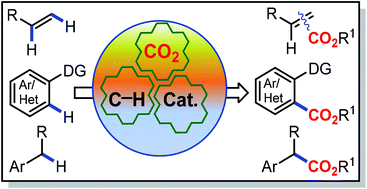Recent advances in the incorporation of CO2 for C–H and C–C bond functionalization
Abstract
Carbon dioxide (CO2) has emerged as an exciting, cost-effective, abundant, and ready-to-use C1 source in synthetic organic chemistry. However, the thermodynamic stability and kinetic inertness of CO2 limit its direct fixation, which can only occur in the presence of air-sensitive organometallic reagents, creating a hurdle for its practical utilization in synthetic chemistry. In the past decade, numerous research groups have explored the successful possibility of incorporating CO2 into organic motifs by directly targeting C(sp2)–H, C(sp3)–H, and unsaturated C–C bonds. Furthermore, diverse methods utilizing metal-based redox catalysis, organic and metal-photo-redox catalysis, and metal-free carboxylation methodologies have been developed to achieve CO2-fixation on a wide variety of unsaturated, saturated, and aromatic motifs. This tutorial review aims to aid readers navigate through the development of CO2 functionalization in this particular research area. Additionally, this review also provides an outline for approaching the synthetic challenges, addressing the potential pitfalls, and recognizing the future directions for CO2 utilization. This tutorial review depicts the important aspects of these developments to help readers navigate the vast pool of tactics involving CO2-fixation, leading to valuable moieties that are widely employed in synthetic, pharmaceutical, material, and bio industries.

- This article is part of the themed collection: Green Chemistry Reviews


 Please wait while we load your content...
Please wait while we load your content...